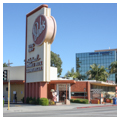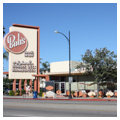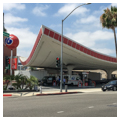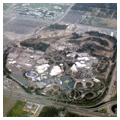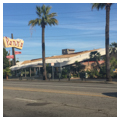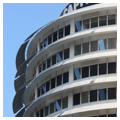In the postwar period, with industry in California booming, migrating workers flocked to the state, more than doubling the population of Los Angeles between 1940 and 1960. This rapid growth led to the expansion of the suburbs, and the once vast tracts of orange groves surrounding the city of Los Angeles became the sites of new housing developments. Simultaneously, the construction of a network of freeways, funded by the 1947 Collier-Burns Highway Act, facilitated transport around this decentralized metropolis. With economic prosperity bringing car ownership within the reach of many more households, and with the warm climate of Southern California making for perfect driving conditions, Los Angeles soon became synonymous with the automobile. Even before the war, business owners realized that motorists represented a new market to be tapped, and commercial roadside establishments proliferated along the avenues and boulevards of Los Angeles. The need to stand out from the competition on the roadside gave rise in the 1930s to the gleaming towers of the Streamlined Moderne style, exemplified by the drive-ins designed by architect Wayne McAllister. With the advent of the Space Age in the 1950s, however, the Art Deco styling of McAllister’s designs fell out of fashion. In its place emerged Googie architecture: a modern, car-oriented style with a futurist aesthetic, and a physical manifestation of this new era of technological advancement.
It was architecture critic Douglas Haskell who, in a 1952 edition of House and Home magazine, christened this new style “Googie,” a name taken from that of a West Hollywood coffee shop designed by John Lautner in 1949. Googie architecture was characterized by a freedom of form, often employing multiple and contrasting materials across diverse structural elements. Sweeping canopies, folded eaves, and tapering pylons became hallmarks of the style, alongside towering neon signage that was typically decorated with boomerang or starburst motifs. Architects such as Douglas Honnold, Armet and Davis, and Powers, Daly and DeRosa became known for their exuberant Googie structures, catering to the increasingly mobile population of Los Angeles with buildings that were designed with the driver in mind.
The development of the drive-in as a building type was instrumental in this regard. The circular stands that typified pre-war drive-ins gave way to increasingly expansive and ever-more elaborate structures at the hands of Googie architects. At Tiny Naylor’s, for instance, a vast canopy in the shape of a rocket ship sheltered both the parked vehicles and the carhops who served them. The dynamic forms of Googie buildings, along with their animated neon signs, were intended to draw the eye of passing motorists and function as architectural advertisements. At Norm’s La Cienega, for example, a roof truss in the shape of an elongated diamond acts as a visual signal that beckons drivers into the coffee shop parking lot. Googie architects borrowed from the iconography of the automobile in order to appeal to motorists; tailfins found architectural expression as wedge-shaped roofs or V-shaped canopies, and molded headlights became parabolas or boomerangs. This marketing strategy proved successful, and roadside establishments such as the Wich Stand and Harvey’s Broiler became destinations of choice for teenage hot-rodders who would cruise the lots on weekend nights, showing off their customized cars.
Googie architecture was not designed for society’s elite; rather, it was architecture for the masses. Architect Victor Newlove, who joined Armet and Davis in 1961, explained the firm’s egalitarian ethos: “We were trying to design for everybody… We did restaurants which everybody related to and could afford to go to.” To make these structures relatable and comprehensible, Googie architects borrowed from the design lexicon of science fiction, a genre that had gained widespread popularity in the 1950s as the Space Race between the United States and the Soviet Union intensified. At the Wich Stand, which opened in the same year that the first Sputnik satellite was launched, a roof canopy adorned with starbursts is pierced by a tapering pylon. This neon spire points skywards, and is seemingly only restrained from rocketing into space by its supporting guy wires. Elsewhere, the flying-saucer form of the Theme Building at Los Angeles International Airport is perhaps the clearest articulation of Googie’s Space Age aesthetic. Googie not only drew from popular culture, but also fed into it. Pop Artist Ed Ruscha inducted Googie into the canon of pop culture with his 1964 painting Norm’s La Cienega On Fire, in which he set the simple geometry of the coffee shop’s iconic architecture ablaze. The teenage hot-rodders who frequented Harvey’s Broiler were among the subcultures profiled by journalist Tom Wolfe, who recounted a Friday night spent in their midst: “They cruise around in their cars in Harvey’s huge parking lot, boys and girls, showing each other the latest fashions in cars, hair-dos (male and female) and clothes.” The Wich Stand, meanwhile, was the subject of an unreleased song written by Brian Wilson of the Beach Boys, in which he described waiting in line in his flaked blue Pontiac to cruise the coffee shop’s parking lot.
With its futuristic forms capturing the atmosphere of optimism and progress in the postwar period, Googie architecture embraced modernity unreservedly. As Douglas Haskell observed, “for Googie architects, anything goes, as long as it is modern.” At Norm’s La Cienega, Armet and Davis were determined to ensure that the interior design would adhere to the modern aesthetic established by the building’s architecture. To achieve this, they oversaw the custom designs for light fittings, upholstery, clocks, menus, door handles, and smallwares. Victor Newlove, who worked on numerous Norm’s restaurants, described this process as a “total design.” Comparisons could be drawn here with the architectural theories of Walter Gropius, founder of the Bauhaus, who called for architects, artists, and craftspeople to collaborate on the construction of a utopian Cathedral of the Future, declaring that “the complete building is the ultimate aim of the visual arts.” In many ways, however, the freeform compositions of Googie buildings are the antitheses of the strict geometry seen in the architectural designs of Gropius and his followers. Googie rejected the austere boxes of the International Style, which had gained traction in the United States with the arrival in the late 1930s of European architects such as Mies van der Rohe, Marcel Breuer, and Gropius himself. This rejection is perhaps one reason why Googie was disparaged by many critics of the day, who viewed the style as crass, kitsch, and out of step with contemporary architectural trends. Nevertheless, Googie did conform to certain Modernist ideals; much like the Case Study houses championed by the architectural press throughout the postwar period, Googie buildings often used steel frames and glass facades to create transparent volumes, opening up their interior spaces to the surroundings. However, while the Case Study houses were typically governed by a restrained rectilinearity, Googie buildings were a mélange of intersecting angles and curves. Googie architects also used high-tech materials and advanced engineering methods to exaggerate architectural features typical of Modernism; not content with the static horizontality of a cantilevered canopy, the Googie architect would instead use steel, gunite, and neon to adorn a building with a set of eye-catching tailfins.
In eschewing the International Style in favor of structural variety, uninhibited form, and the use of contrasting materials, the Googie aesthetic is not dissimilar to that of Postmodernism, which would begin to develop throughout the 1960s and 1970s. In his 1966 book, Complexity and Contradiction in Architecture, a seminal text that would form the foundation of Postmodern architecture, Robert Venturi advocated “a complex and contradictory architecture based on the richness and ambiguity of modern experience… I am for messy vitality over obvious unity … I prefer ‘both-and’ to ‘either-or’… More is not less.” These extracts could serve as a fine description of Googie architecture, and it is tempting to position Googie as a precursor to Postmodernism. Indeed, it would take no great leap of imagination to draw a line from the neon arches of Stanley Meston’s McDonald’s stands to those of Charles Moore’s Piazza d’Italia in New Orleans. However, while Googie might share a superficial resemblance to Postmodern architecture, the two styles were ideologically opposed. Postmodernists appealed to history, drawing architectural inspiration from the past as a means of remedying their dissatisfaction with modernity and rectifying the perceived failure of Modernism. Googie, on the other hand, had its gaze fixed firmly on the horizon, looking optimistically toward the future and celebrating the innovations of the modern age. Moore’s arches were neoclassical monuments; Meston’s were space-age paraboloids.
By the time academics began to take notice of Googie, the style was already in the rearview mirror. One relatively early study that took a broad look at the roadside architecture of Los Angeles was conducted by Reyner Banham, a professor of architecture at University College London. Banham analyzed the Los Angeles streetscape, which he characterized as an “Autopia,” in his 1971 work, Los Angeles: The Architecture of Four Ecologies. He even filmed part of his 1972 documentary, Reyner Banham Loves Los Angeles, from the parking lot of Tiny Naylor’s drive-in, which he visited in the company of Ed Ruscha. That same year also saw the publication of Learning from Las Vegas by Robert Venturi, Denise Scott Brown, and Steven Izenour. The text provides a useful analytical framework for examining Googie designs, many of which exemplified the “decorated shed” building type (i.e., a simple structure adorned with ornament and signage) identified by the authors during their study of the Las Vegas strip. The photographic archive of Julius Shulman, the celebrated architectural photographer who documented the urban development of midcentury Los Angeles, remains another valuable resource for the Googie historian. However, the first author to truly examine, and indeed define, Googie architecture was architect and historian Alan Hess, in his 1985 book Googie: Fifties Coffee Shop Architecture (republished in an expanded form in 2004 as Googie Redux: Ultramodern Roadside Architecture). Hess was not only responsible for popularizing the name “Googie” beyond Haskell’s 1952 article, but also for identifying the characteristics of the style, developing a vocabulary with which to discuss it, and cataloguing many of its buildings of significance. In Hess’s book, these ephemeral roadside structures coalesced into a perceptible, appreciable style.
Throughout the 1960s and into the 1970s, a growing sense of national anxiety, fueled by factors such as the Cuban Missile Crisis, the ongoing Vietnam War, and the assassination of John F. Kennedy, gradually supplanted the excitement surrounding the Space Race and the Atomic Age. Googie’s optimism about the modern era suddenly seemed misplaced; its populist forms were no longer in keeping with the cultural zeitgeist. Business owners either rebuilt or remodeled their commercial roadside establishments in a more conservative style, and mansard roofs replaced Googie’s soaring cantilevered canopies. Tiny Naylor’s, Ship’s Westwood, the Laurel Canyon Carwash, and many others fell victim to the wrecking ball. More recently, however, Googie has seen a resurgence in popularity, due in no small part to Alan Hess’s writings. Though many Googie buildings remain under threat of demolition, local activists and preservation campaigns, often spearheaded by the Los Angeles Conservancy’s Modern Committee (formerly operating as the evocatively titled Fifties Task Force), have been successful in rescuing such landmark structures as Bob’s Big Boy Broiler, the Downey McDonald’s, and Johnie’s Coffee Shop. These iconic Googie locations have formed the backdrop to countless movies and television shows, their distinctive architectural style often used as a means of visually communicating a midcentury time period. That Googie did not endure as a style is perhaps unsurprising; it was born on the shifting streetscapes of a growing city, and shaped by fleeting popular tastes during a period of rapid social change. The Googie landmarks that remain, then, stand as significant historical artifacts; they are the unique product of a particular time and place, shaped by the power of the Atomic Age in the automotive city of Los Angeles.
References
Banham, Reyner. Los Angeles: The Architecture of Four Ecologies. 1971; Reprint, Harmondsworth, Eng.: Pelican Books, 1973.
De Wit, Wim, and Christopher James Alexander, eds. Overdrive: L.A. Constructs the Future, 1940-1990. Los Angeles: Getty Publications, 2013.
Haskell, Douglas. “Googie Architecture.” House and Home 1 (February 1952): 86-88.
Hess, Alan. Googie: Fifties Coffee Shop Architecture. San Francisco: Chronicle Books, 1985.
Hess, Alan. Googie Redux: Ultramodern Roadside Architecture. San Francisco: Chronicle Books, 2004.
Hine, Thomas. Populuxe. London: Bloomsbury, 1992.
Jakle, John A. Fast Food: Roadside Restaurants in the Automobile Age. Baltimore: John Hopkins University Press, 1999.
Venturi, Robert. Complexity and Contradiction in Architecture. 1966; Reprint, New York: Museum of Modern Art, 1992.
Venturi, Robert, Denise Scott Brown, and Steven Izenour. Learning from Las Vegas. Cambridge: MIT Press, 1972.
Wolfe, Tom. The Pump House Gang. London: Black Swan, 1989.
Writing Credits
If SAH Archipedia has been useful to you, please consider supporting it.
SAH Archipedia tells the story of the United States through its buildings, landscapes, and cities. This freely available resource empowers the public with authoritative knowledge that deepens their understanding and appreciation of the built environment. But the Society of Architectural Historians, which created SAH Archipedia with University of Virginia Press, needs your support to maintain the high-caliber research, writing, photography, cartography, editing, design, and programming that make SAH Archipedia a trusted online resource available to all who value the history of place, heritage tourism, and learning.

